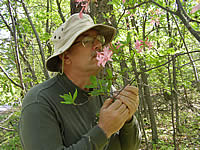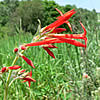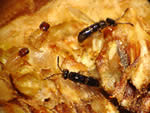USDA Forest Service Celebrating Wildflowers
|
|
|
Plant Pollination StrategiesScent
Some flowers use scent to attract their pollinators. These floral scents are derived from essential oils that are highly volatile. Flowers that use scents to attract their pollinators are generally drab in appearance, white or purple-brown to dark red-brown and exude very strong scents that can be detected at a distances over 1 kilometer. The flower’s pollinator detects the scent and follows the concentration gradient of the chemical producing the scent to the flower. How many times have you been intoxicated by the smell of a flower? Many of the chemicals used in aromatherapy are derived from floral scent chemicals; i.e. essential oils. Research that has been conducted in the past several years has shown that greenhouse gases from fossil fuels can decrease the concentration of volatile oils (scent) and the distance at which the scent can still be detected by pollinators. Further research is needed to determine the effects of flowers being successfully pollinated and the ability of the pollinators to find the nectar and pollen to sustain their populations. |
|
| NOTE: PDF format links require the Adobe Acrobat Reader to view. | |
| top | Disclaimers | FOIA | Privacy Policy | Quality of Information | Photo Credits & Use |
Location: http://www.fs.fed.us/wildflowers/pollinators/plantstrategies/scent.shtml
Last modified: Monday, 19-May-2008 14:02:17 EDT


